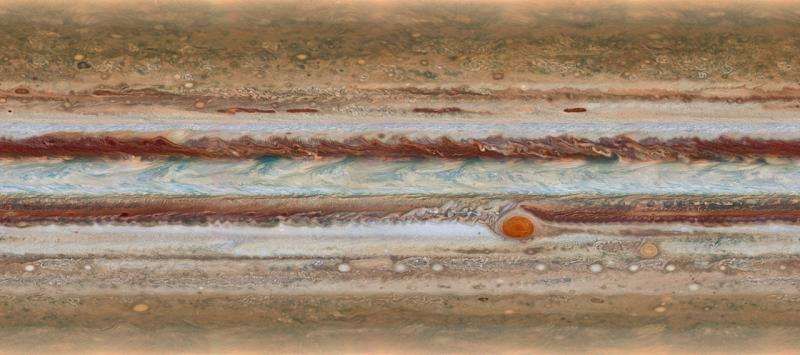Hubble's planetary portrait captures changes in Jupiter's Great Red Spot

Scientists using the NASA/ESA Hubble Space Telescope have produced new maps of Jupiter that show the continuing changes in its famous Great Red Spot. The images also reveal a rare wave structure in the planet's atmosphere that has not been seen for decades. The new image is the first in a series of annual portraits of the Solar System's outer planets, which will give us new glimpses of these remote worlds, and help scientists to study how they change over time.
In this new image of Jupitor a broad range of features has been captured, including winds, clouds and storms. The scientists behind the new images took pictures of Jupiter using Hubble's Wide Field Camera 3 over a ten-hour period and have produced two maps of the entire planet from the observations. These maps make it possible to determine the speeds of Jupiter's winds, to identify different phenomena in its atmosphere and to track changes in its most famous features.
The new images confirm that the huge storm, which has raged on Jupiter's surface for at least three hundred years, continues to shrink, but that it may not go out without a fight. The storm, known as the Great Red Spot, is seen here swirling at the centre of the image of the planet. It has been decreasing in size at a noticeably faster rate from year to year for some time. But now, the rate of shrinkage seems to be slowing again, even though the spot is still about 240 kilometres smaller than it was in 2014.
The spot's size is not the only change that has been captured by Hubble. At the centre of the spot, which is less intense in colour than it once was, an unusual wispy filament can be seen spanning almost the entire width of the vortex. This filamentary streamer rotates and twists throughout the ten-hour span of the Great Red Spot image sequence, distorted by winds that are blowing at 540 kilometres per hour.
There is another feature of interest in this new view of our giant neighbour. Just north of the planet's equator, researchers have found a rare wave structure, of a type that has been spotted on the planet only once before, decades ago by the Voyager 2 mission, which was launched in 1977. In the Voyager 2 images the wave was barely visible and astronomers began to think its appearance was a fluke, as nothing like it has been seen since, until now.
The current wave was found in a region dotted with cyclones and anticyclones. Similar waves—called baroclinic waves—sometimes appear in the Earth's atmosphere where cyclones are forming. The wave may originate in a clear layer beneath the clouds, only becoming visible when it propagates up into the cloud deck, according to the researchers.

The observations of Jupiter form part of the Outer Planet Atmospheres Legacy (OPAL) programme, which will allow Hubble to dedicate time each year to observing the outer planets. In addition to Jupiter,Neptune and Uranus have already been observed as part of the programme and maps of these planets will be placed in the public archive. Saturn will be added to the series later. The collection of maps that will be built up over time will help scientists not only to understand the atmospheres of giant planets in the Solar System, but also the atmospheres of our own planet and of the planets that are being discovered around other stars.
More information: The findings are described in an Astrophysical Journal paper First results from the Hubble OPAL program: Jupiter in 2015, available online.
Journal information: Astrophysical Journal
Provided by ESA/Hubble Information Centre





















